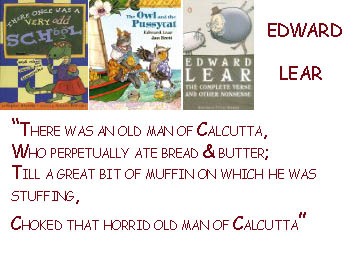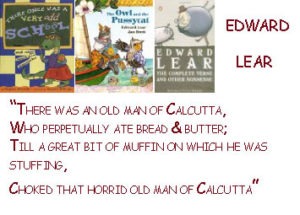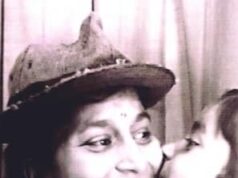April has been a Poetry Month. As we have Poem in a Bag and Poetry Learning at Swagat Children Library, here’s Poetry Pages for Teachers (Poetry in classrooms)and in Poetry Corner.
As you go for Poetry Learning, the form of Poetry you will love is Limericks and esp. Edward Lear who was born in May. Here’s a brief Profile of the Author and Limericks.
Edward Lear, an English writer and artist, became famous for his humorous poems for children. Born in London on May 12 1812, Lear’s first book of poems, “A Book of Nonsense” (1846) ranks as a masterpiece of children’s literature. His best known “The owl and the Pussy-cat” became a classic too.
That old man of Melrose
Who walked on tip of his toes
But they said it ain’t pleasant
To see u at present
You stupid old man of Melrose
Well, Limericks is a form of humorous verse. It takes it’s name from the city of Limerick, Ireland. No one knows how or where the form originated. It became known after Edward Lear made the form popular with his first “A Book of Nonsense (1846). The Limerick is a poem of five lines, with strong beat and rough anapaestic rhythm (i.e. de-de-DUMM). It is written in Poulter’s measure, a Folk Metre that consists of 13 beats. The first two lines rhyme with the fifth, the third line rhymes with the fourth.
Parents often come to me and request that their kids learn to write poetry – Just because their poetry need to be selected and they have to recite at a Recitation competition or get it printed in the school magazine.
Learning to write poetry in two to four sessions is not a miracle. Kidsfreesouls suggest Poetry Soup Ideas and here’s some simple steps:
1. Build Vocabulary – two-three-four-five-six letter words – Be familiar with words and just words
2. Rhyme words – Find all rhyming words and make a list
3. Select topics from Poetry Soup – Write on school, hobby, animals, etc.
4. Say some Tongue Twisters – To get familiar with rhyming words with pleasure when you say “Betty bought some butter, but the butter was bitter, so betty bought some better butter, to make the bitter butter, better.”
5. Let imagination swirl – Write down all your great ideas.
Now, when I talk of Rhymes, words rhyming together give a musical chime of sound and this is the reason why rhyme is so much used. I am fond of rhyming words and I think, Internal rhymes also add music. For eg.
“The Ice was here and the Ice was there,
The Ice was all around;
It cracked and growled, and roared and howled,
Like noises in a sound!”
Vowel and Consonant sound words like long open vowels and soft consonants like l, m, n, v, w, z, etc produce sweet, soft, soothing music. Alliteration is yet another way to add zing to poetry. Repetition of words and phrases in poetry not only emphasize the meaning but often give musical effect to the poem.
For eg. “In ever climbing up a climbing wave” (Tennyson) or “The western tide crept up along the sand, And o’er and o’er the sand, And round and round the sand” (Kingsley)
Another thing I observed while writing Poetry. Poets have three ways of making us see mental pictures as we let our Imagination soar higher to pen down:
1. By Description : Describing a scene, character, real or ideal, in words. Eg. Henry Longfellow’s ‘Rain in Summer’ (Search in Google Here)
2. By Figures of Speech : Such as simple, metaphor and personification. Compare one thing with another.
3. By Picturesque way : A poet can call up for a picturesque image with descriptive words like, eg. “All in a hot and copper sky, The bloody sun, at noon” (Coleridge)
Imagination and Emotions – two things to blend for an appeal. And which other poetry can go best than ‘Daffodils’ by William Wordsworth (Search in Google Here) – It touches the heart as we recite to end up,
“…They flash upon that inward eye, Which is the bliss of solitude; And then my heart with pleasure fills, And dances with the daffodils.”
April has been a Poetry Month. As we have Poem in a Bag and Poetry Learning at Swagat Children Library, here’s Poetry Pages for Teachers (Poetry in classrooms)and in Poetry Corner.









